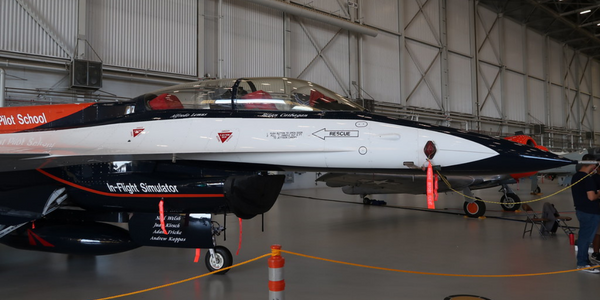AI Goes Top Gun in New Aviation Milestone

AI has reached a new milestone in aviation as a VISTA (Variable In-flight Simulation Test Aircraft) training fighter jet successfully completed a 17-hour test flight officials announced this week. The plane, an unmanned combat aerial vehicle, was flown this past December by an AI algorithm that mimics the performance of characters of other aircraft.
The UCAV (unmanned combat aerial vehicle) used in the test flight was a modified F-16 Fighting Falcon, a single-engine supersonic fighter aircraft that has been used by the U.S. Air Force since the 1970s. The modified aircraft was equipped with a suite of sensors and avionics to enable it to operate without a human pilot. These included a radar system, a camera system, and an inertial measurement unit, which together enabled the AI algorithm to make decisions about the aircraft’s flight path and respond to changing conditions.
Air Force Lt. Col. Ryan “Hal” Hefron, the DARPA program manager for ACE, said in a statement. “We conducted multiple sorties [takeoffs and landings] with numerous test points performed on each sortie to test the algorithms under varying starting conditions, against various simulated adversaries, and with simulated weapons capabilities…We didn’t run into any major issues but did encounter some differences compared to simulation-based results, which is to be expected when transitioning from virtual to live.”
The test flight was part of the U.S. Air Force’s “Skyborg” program, which aims to develop low-cost, autonomous combat aircraft to support manned aircraft in battle. The success of this flight is a significant step forward in developing unmanned combat systems, which can potentially transform the way the military operates in the future. This comes as sixth-generation fighter jets are expected to have the option to fly without pilots.
As one could imagine there are concerns about the development of autonomous combat systems. Some experts have warned that these systems could lead to a new arms race, as countries compete to develop increasingly sophisticated AI algorithms and unmanned combat systems. There are also concerns about the potential for AI to make decisions that could result in unintended consequences or harm to civilians.
The United States isn’t the only nation eyeing AI’s potential use in air combat. As reported by the BBC, the UK, Japan, & Italy are teaming up to develop a new fighter jet with AI in mind. With even reports of the Russian Federation and the Chinese government also looking to AI as the future of their next-generation aircraft. This all comes as last year Boston Dynamics and a group of other robotic-focused companies and startups wrote an open letter committing to not weaponize robots in a bid to not see the technology become involved in an arms race.
Originally posted on OpenDataScience.com
Read more data science articles on OpenDataScience.com, including tutorials and guides from beginner to advanced levels! Subscribe to our weekly newsletter here and receive the latest news every Thursday. You can also get data science training on-demand wherever you are with our Ai+ Training platform. Subscribe to our fast-growing Medium Publication too, the ODSC Journal, and inquire about becoming a writer.
